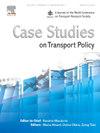High-Speed rail and air transport competition: A game theoretical approach to a potential European case study
IF 3.3
Q3 TRANSPORTATION
引用次数: 0
Abstract
This study explores competition between High-Speed Rail (HSR) and air transport by analysing two strategically significant Eastern European corridors: Bucharest–Budapest (Northern Balkans) and Bucharest–Athens (Southern Balkans). Using a game-theoretical framework, the research integrates heterogeneous passenger value-of-time segments, modelling strategic fare and frequency decisions under realistic constraints. The total cost function incorporates a modal preference coefficient, reflecting passenger attitudes towards transport modes beyond traditional cost and time factors. Findings reveal that HSR is highly competitive on medium-distance routes like the Northern Balkans corridor due to its efficiency and scalability. Air transport maintains an advantage on longer routes, particularly where travellers value time highly. Increased total demand significantly boosts HSR profitability, while airlines experience declining profits amid intensified competition. Higher-income passengers benefit both modes, though HSR’s profitability relies more on market share than premium pricing. The analysis provides novel, policy-relevant insights, highlighting conditions for viable HSR infrastructure investments and implications for sustainability, regional integration, and resource allocation.
高速铁路和航空运输竞争:一个潜在的欧洲案例研究的博弈论方法
本研究通过分析两条具有重要战略意义的东欧走廊:布加勒斯特-布达佩斯(巴尔干半岛北部)和布加勒斯特-雅典(巴尔干半岛南部),探讨了高速铁路(HSR)与航空运输之间的竞争。利用博弈论框架,本研究整合了不同类型的乘客时间段价值,在现实约束下对票价和频率决策进行建模。总成本函数包含一个模式偏好系数,反映了乘客对传统成本和时间因素之外的运输方式的态度。研究结果显示,由于高铁的效率和可扩展性,高铁在北巴尔干走廊等中距离线路上具有很强的竞争力。航空运输在较长的航线上保持优势,特别是在旅客高度重视时间的航线上。总需求的增加显著提高了高铁的盈利能力,而航空公司在竞争加剧的情况下利润下降。高收入乘客对两种模式都有好处,尽管高铁的盈利更多地依赖于市场份额,而不是溢价定价。该分析提供了新颖的、与政策相关的见解,突出了可行的高铁基础设施投资条件以及对可持续性、区域一体化和资源配置的影响。
本文章由计算机程序翻译,如有差异,请以英文原文为准。
求助全文
约1分钟内获得全文
求助全文

 求助内容:
求助内容: 应助结果提醒方式:
应助结果提醒方式:


